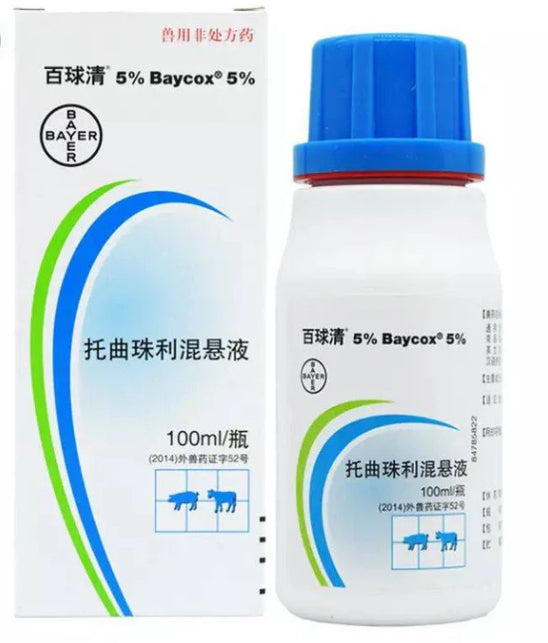Baycox (toltrazuril) 5% Oral Suspension (coccidiosis treatment)
Baycox (toltrazuril) 5% Oral Suspension (coccidiosis treatment)
Once paid for, it can not be canceled
All breeders need to keep this in hand.
2wk delivery
Baycox® is indicated for the treatment of preclinical coccidiosis due to Isosporasuis in neonatal piglets, for the prevention of clinical signs of coccidiosis and reduction of coccidian shedding in lambs on farms with aconfirmed history of coccidiosis caused by Eimeriacrandallis and Eimeria ovinoidalis,and for the prevention of clinical signs of coccidiosis and reduction of coccidian shedding in calves on farms with a confirmed history of coccidios is caused by Eimeria bovis and Eimeria zuernii.
Baycox® is not indicated for use in feedlot cattle.
Dosage and Administration: Piglets: Shake well before use. Weigh three representative litters at 3 days of age to determine an average piglet weight. The recommended dosage of toltrazuril is 20 mg per kgbody weight. This corresponds to a dose of 1 mL Baycox® per 2.5 kg bodyweight.
Administer a single oral dose at 3 to 4 days of age.
Lambs: Shake well before use. Each animal should be treated with a single dose of 20 mg toltrazuril/kg body weight corresponding to 1 mL Baycox® per 2.5 kg body weight. To obtain maximum benefit, sheep should be treated in the prepatent period before the expected onset of clinical signs. The prepatent period of Eimeriaovinoidalis is 12-15 days and the prepatent period of Eimeria crandalis is 15-20 days. If animals are to be treated collectively rather than individually, they should be-grouped according to their body weight and dosed accordingly, in order to avoidunder- or overdosing. In order to maximize effectiveness of Baycox® in lambs it is important to time therapy according to individual farm management and lifecycle of the organism involved.
Calves: Shake well before use. Each animal should be treated with a single oral dose of 15 mg toltrazuril/kg body weight corresponding to 3mL Baycox® per 10 kg body weight. To obtain maximumbenefit, calves should be treated in the prepatent period before the expected onset of clinical signs. The prepatent period of Eimeriazuernii is 15-17 days and the prepatent period of Eimeria bovis is 18-21 days. If animalsare to be treated collectively rather than individually, they should be grouped according to their body weight and dosed accordingly, in order to avoid under-or overdosing. It is important to time therapy according to individual farm management and lifecycle of the organism involved.
Cautions:
As with any antiparasiticide, frequent and repeated use ofantiprotozoals from the same class may lead to the development of resistance.
Warnings:Piglets: Treated swine must not be slaughtered for use in food forat least 70 days after the latest treatment with this drug. Do not use inpiglets intended to be used as suckling or barbecue pigs since they may bemarketed before 70 days after administration of this drug. Lambs: Treated sheep must not be slaughtered for use in food for at least 48 days after the latest treatment with this drug.
- Do not use in lactating sheep producing milk for humanconsumption.
Calves: Treated cattle must not be slaughtered for use in food forat least 63 days after the latest treatment with this drug.
- Do not use in calves to be processed for veal. A withdrawal period has not been established for this product in pre-ruminating calves.
- Do not use in lactating dairy cows producing milk for humanconsumption.
Avoid direct contact with skin by wearing rubber gloves while handling this drug. Dispose the unused drug in accordance with the Provincial/Municipal guidelines
Breeders should always have Toltrazuril 5% on hand to combat coccidiosis and protozoal infections in their dogs, cats, and horses. This veterinarian-recommended treatment is a powerful coccidia cure, not just a suppressant like many other drugs. It prevents oocyst shedding, reduces lesion severity, and improves growth rates in young animals, making it essential for breeders managing litters.
Unlike other treatments, Toltrazuril 5% suspension is safe, effective, and well-tolerated, with no impact on intestinal flora. It eliminates Cystoisospora and Sarcocystis neurona at all intracellular stages, preventing reinfection. A single dose can cure coccidiosis in puppies and kittens, ensuring healthier litters and faster weight gain.
For breeders, early treatment at 4-6 weeks helps prevent outbreaks, keeping their kennels and catteries disease-free. Investing in Toltrazuril 5% for dogs, cats, and horses means fewer vet bills, healthier animals, and increased breeding success. Available in flavored formulas for easy dosing, it’s a must-have for dog breeders, cat breeders, and horse owners looking to maintain top-quality health standards. Keep Toltrazuril 5% in your breeding toolkit today!
Product features
Product features
Materials and care
Materials and care
Merchandising tips
Merchandising tips
Share

